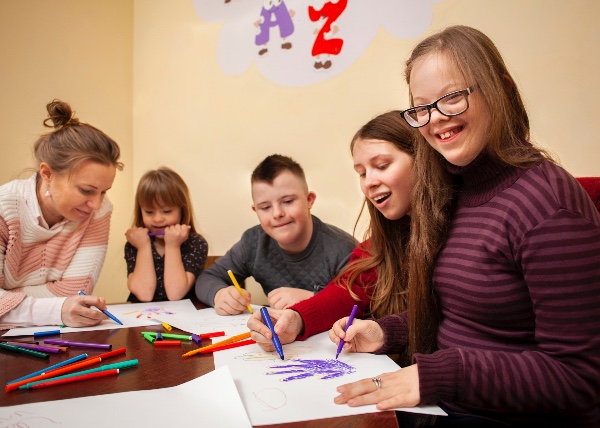Functional Behaviour Assessment
Functional behaviour Assessment (FBA) is an evidence-based and systematic assessment process of collecting and analysing information from various sources that helps to gain insights into the factors contributing the behaviour and identify why a behaviour is occurring i.e., the “function/s” of the behaviour.
If we know why someone is exhibiting behaviours of concern, we can structure an effective response in order to assist them.
In a variety of settings, FBAs are an essential tool for gathering information so we can write an effective Positive behaviour Support Plan (PBSP). The PBSP involves utilising a person-centred and strength-based approach to address the needs of the individual, the underlying causes of behaviours of concern and overall quality of life.
PBSP are useful to support the individual in settings such as home, school / college, day service, short breaks / respite, family members or friend's homes, out in the community and on holiday.
FBAs are commonly used when an individual is exhibiting behaviours of concern that are of such frequency, intensity and duration that they are negatively impacting their daily life, education, leisure, work, and social life.
A positive behaviour support plan can be useful for children, adolescents and adults with emotional and behavioural difficulties, developmental delays, autism spectrum disorder, intellectual disability, learning disabilities, dementia and mental health disorders.
A functional behaviour assessment is useful with supporting children, adolescents and adults with emotional and behavioural difficulties.
Here at behaviour help we use FBAs regularly to address behaviours of concern. We also advocate for their use by teachers, care givers and parents and can provide training on how to conduct FBAs in the home, at school or in a care setting.
We also provide an app called ‘Behaviour Help App'. The Behaviour Help App is an innovative web-based app that can be used on all technologies i.e. Apple or Android smartphones, tablets or on PC or laptop. The app allows you to complete data-driven Functional Behaviour Assessments (FBAs) and develop comprehensive positive behaviour support (PBS) plans to address the behaviours of concern, teach new skills to maximise the individual’s participation, quality of life, independence, and development across multiple domains.

Introducting...The Behaviour Help App
Your All-in-One AI Tool for FBAs and PBS plans
You’re doing important work. That’s why we built the Behaviour Help App — to make it easier to track behaviour trends, identify patterns, and develop meaningful, person-centred strategies.
Specifically in regards to the FBA the Behaviour Help App guides the PBS professional to step by step through the following components:
- Individual’s profile: Gather information about the individual to create a comprehensive picture of the individual, their context and systems of support.
- Behaviour data collection forms: The app allows multiple team members to record by inputting measurable details (e.g. frequency, intensity, duration) about the behaviours of concern by observing the individual in different settings. The app then collates the metric data, analyses and captures patterns.
- A-B-C analysis: The app allows multiple team members to systematically input incident details by recording the antecedents (what preceded the behaviour), behaviours (describing the observable actions as they occurred) and the consequences (what happened after the behaviour). The app then collates all the incidents into an incident register system for easy analysis.
- Hypothesis: By reflecting on both the qualitative and quantitative data the most likely purpose (i.e., function) that the behaviour of concern serves for the individual and what reinforces that behaviour to occur again can be determined.
The Behaviour Help app then generates a downloadable functional behaviour assessment report thatcan be printed or saved as a PDF to be shared with the individual's support team.

In the United States, the Office of Special Education and Rehabilitative Services (OSERS) provides a description of a Functional Behaviour Assessment:
Functional behavioral assessment (FBA) is used to understand the function and purpose of a child’s specific, interfering behavior and factors that contribute to the behavior’s occurrence and non-occurrence for the purpose of developing effective positive behavioral interventions, supports, and other strategies to mitigate or eliminate the interfering behavior.
Source: Using Functional Behavioural Assessments to Create Supportive Learning Environments
Key Observations of a Functional behaviour Assessment
Observations are the foundation of any FBA. Whenever a behaviour of concern takes place, we are looking to observe:
- The context, precursors and surrounding environmental factors. What led to the individual behaving this way? (antecedent)
- The behaviour itself, what did the individual do? How did they behave in that moment? (behaviour)
- What were the consequences? (consequence)
A great way to remember the types of observations we need to carry out is ‘ABC': Antecedent, behaviour, Consequence.
The purpose of these observations is to try and understand the purpose of the behaviour of concern (such as attention, escape, access and sensory needs) to then allow us to tailor a personalised Positive behaviour Support Plan (PBSP). Sometimes these are referred to as 'challenging behaviours'.
An example assessment
Jacob bangs his feet on the floor during independent reading time in the classroom (the antecedents). The more his teacher tells him to be quiet the louder he bangs his feet and the more he distracts his classmates (the consequences).
After this challenging behaviour continues for the first few months of school, his teacher is feeling stuck with how to respond and requests an FBA. The school does an FBA and learns that Jacob does not get attention from important people when he reads quietly.
As soon as he starts banging his feet, his teacher (who he likes) and his classmates start paying attention to him and he gets to avoid doing his reading which he finds boring.
The primary goal of an FBA is to identify the factors that contribute to the occurrence and maintenance of a particular challenging behaviour in the learning environment.
Based on this information, a Positive behaviour Support Plan (PBSP) is designed to help manage the student's behaviour. The interventions included in the behaviur support plan are customised to meet the specific needs of the individual based on insights into the underlying reasons for the student's behaviour.
Research has shown that interventions developed from an FBA are more likely to be effective in reducing the rates of concerning behaviours.
Collaboration between parents, care givers and educators during assessment
Critical to observing behaviours of concern is a collaboration between the various team members such as parents, educators, allied health professionals, disability support workers, and other key people. When conducting an FBA work together to record observations in a consistent format and bring your findings together.

Effectiveness of Functional behavioural Assessment
It is important to stress that the nature of these observations only ever have the long term welfare of the individual in mind. The FBA isn't about ‘calling out' concerning or challenging behaviours or policing ‘bad behaviour', the assessment is more about understanding the context and triggers that cause outbursts so we can all help.
FBAs are very effective. They help us develop personalised interventions tailored to the specific needs of the individual. They are very proactive and aim to address the environmental triggers of the behaviour of concern rather than just reacting to the behaviour itself.
Perhaps most importantly, FBAs significantly reduce inappropriate interventions. By understanding the functions of a behaviour, inappropriate or ineffective interventions (like punishment that doesn't address the root cause) can be avoided.
There is also widespread professional support in psychology, education, special education, and behavioural therapy advocating for the use of functional behaviour assessments.
Organisations like the American Psychological Association and various educational bodies often recommend FBAs as best practice.
However, FBAs can be time consuming and consume significant resources. Some also raise ethical concerns in terms of gathering detailed information about a student's behaviour.
In order to conduct an effective functional behavioural assessment that truly serves the individual concerned, it is helpful to be aware of these criticisms in order that we can find ways to ensure the observations are ethical, do respect privacy and try not to consume too much of the teacher, parent or care giver's time.

FBAs for Individuals with Learning Disabilities or Behavioural Conditions
Functional behaviour assessments are particularly useful for individuals with emotional and behavioural difficulties because they can assist with the team supporting the individual to develop a shared understanding of the reasons underlying behaviour of concern. Then using this understanding to develop a PBSB.
The resulting PBSP is so personal and individualised, they help us develop a deep understanding of what triggers and reinforces problematic behaviour and therefore what interventions can be most effective.
Behaviour is a form of communication. FBAs help in interpreting this 'language,' understanding what the individual is trying to convey or achieve through their behaviour.
In this vein, FBAs respect the individuality of each person. By avoiding one-size-fits-all solutions, they promote inclusivity and respect for the person's needs and circumstances.
Hence, FBAs are a very positive tool in achieving positive outcomes.

Examples of Challenging behaviour Where Functional behavioural Assessments can help
Functional behavioural Assessments (FBAs) are valuable tools in addressing a wide range of challenging behaviours in mainstream education, special education, in care and at home.
Aggression
Aggressive behaviour, such as hitting, biting, or throwing objects, can pose significant challenges in educational and caregiving settings. An FBA can help identify whether the behaviour is triggered by frustration, communication difficulties, or sensory overload.
FBA for Aggression Case Study
Lucy is a 16-year-old with a diagnosis of Acquired brain injury, Epilepsy, and Anxiety.
An FBA was conducted to identify the specific function(s) of the aggressive behaviour. The FBA highlighted Lucy’s aggressive behaviour serves the purpose of escaping or avoiding stimuli, people, tasks, or activities she finds aversive. For example, in the classroom Lucy would become aggressive if there was:
- Too much structure or not enough structure;
- Too many demands being placed on her without adequate rest breaks;
- Too many complex verbal instructions being given to her without visual supports; and
- Being told she could not do something.
Based on these findings it allowed her educators to modify instructional strategies, inset regular rest breaks and use visual supports to provide structure.
Self-Injurious behaviour (SIB)
Self-injurious behaviour (SIB), such as head-banging, scratching, or biting oneself, are often seen in individuals with autism spectrum disorder or severe intellectual disabilities. FBAs can uncover the purpose/ function the SIB serves.
For example, SIB might be a way to manage or distract from other forms of pain, such as emotional or psychological pain; SIB may provide sensory feedback or stimulation to cope with under or over stimulation; escape from or avoid a stressful or undesired situation or demand.
If you have concerns, always speak to a behaviour specialist or school psychologist.
FBA for Self-Injurious Behaviour Case Study
Ned is a 17-year-old young male with a diagnosis of Autism Spectrum Disorder (ASD)-Level 3, Severe Intellectual Impairment and Dyslexia.
His FBA involved collecting data on the antecedents, behaviours, and consequences to understand the context and triggers of Ned’s SIB. The FBA helped identify that Ned's SIB behaviour serves the purpose of escaping or avoiding stimuli, people, tasks, or activities he found aversive or to gain/obtain items.
For example, at home Ned would hit his head if he did not like a particular show that was on TV or wanted an unfamiliar person (e.g. tradesperson) to leave the house or was waiting for a motivating item (e.g. muffin to finish baking).
Based on these findings effective communication strategies were identified to help Ned develop Functionally Equivalent Replacement Behaviours (FERB) that allow him to obtain or escape something in a contextually appropriate way.
Disruptive Classroom behaviours
behaviours like frequent outbursts, refusal to follow instructions, or disrupting peers can significantly impede learning. An FBA can help determine if these behaviours are attempts to avoid difficult tasks, seek peer attention, or cope with academic pressures. Understanding these triggers allows educators to modify instructional strategies, provide additional support, or introduce positive reinforcement systems to encourage appropriate behaviour.
FBA for Disruptive Classroom Behaviours
Andrea is an eight year old with a diagnosis of Intellectual disability, Vision impairment (Esotropia, Strabismus) and Prader–Willi syndrome (PWS) with a distinct genetic mechanism of Uniparental Disomy (UPD).
The FBA highlighted that in the classroom setting Andrea would exhibit disruptive behavours if she did not have an education assistant supporting her during a classroom activity. The education assistant would help Andrea get organised for the activity (e.g. for a craft activity the education assistant would find a glue stick, scissors and colouring pencils for her).
The education assistant would help remind Andrea of the steps of the activity that had been verbally provided by the teacher. Whilst this was extremely helpful and supportive of Andrea the difficulty was when the education assistant was not present Andrea did not have the skills to engage in the activity independently.
Based on these findings intervention strategies were identified to promote Andrea’s independence skills by using a range of visual supports so that she did not have to rely on her education assistant to help her organise and complete an activity.
For example, provide a ‘What do I need before I get started?’ checklist so that Andrea can get make sure she has all the necessary items before starting an activity. We could also provide Andrea with a step by step breakdown of the task (or mini schedule) so that she can learn how to use to complete the activity independently.
Positive Behaviour Support Plans
After conducting a thorough Functional behavioural Assessment (FBA) and gaining a deep understanding of the factors contributing to challenging behaviours, the next critical step is the development of a Positive behaviour Support Plan (PBSP).
PBSPs are comprehensive, individualised strategies designed to address the specific needs and circumstances of the individual, promoting positive behavioural changes and enhancing overall quality of life. The PBSP is sometimes known as a 'behaviour intervention plan'.
PBSPs are not just about managing behaviour; they are about understanding and supporting the individual in a holistic manner. These plans leverage the insights gained from the FBA to implement proactive, educational, and reinforcement-based strategies. By focusing on positive behaviour support, we can create a nurturing environment that encourages desirable behaviours, reduces the occurrence of problematic behaviours, and fosters personal growth and well-being.
In summary, Positive behaviour Support Plans are essential tools in the journey from understanding to intervention. They provide a structured, empathetic, and effective framework to support individuals in achieving positive outcomes, ensuring they lead fulfilling and empowered lives.
To learn how to develop a PBSP the Behaviour Help app can guide you step by step to develop a comprehensive management and prevention plan. This can be printed or saved as a PDF to be shared with the individual’s support team so that the team can consistently manage and prevent behaviours of concern across different settings.
Read Next:

